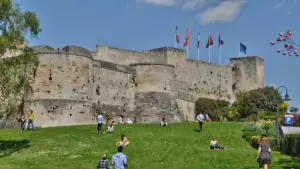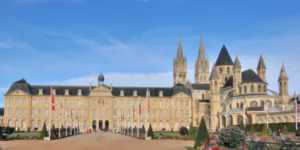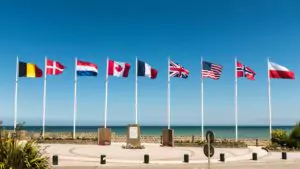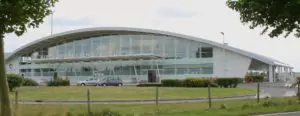By Stefaan Ghijs
Second largest city in Normandy after Rouen, the city of Caen is known for its culture, heritage and historical sites built during the reign of William the Conqueror, Duke of Normandy and King of England, in the 11th century. Not far from the Norman seaside resort of Deauville and the largest port of France, Le Havre, Caen is a 2 hour drive from Paris but only 10 minutes from some of the Normandy D-Day beaches. In this blog, you will find out more about the “City of a Hundred Spiers” and its surroundings by landing in the Caen-Carpiquet airport.
Do you want to discover other destinations in France by private jet and know our prices? Check out our online price calculator!
Caen, historic town of Normandy
Caen is the second agglomeration of Normandy. Today this region is world famous for its landing beaches, though its history is much richer and older. A little history lesson might be in order…
From the end of the 8th century, Viking invasions devastated the region. To put an end to these incessant and bloody raids, the King of the Franks, Charles III “the Simple”, descendant of Charlemagne, decides to start negotiations with a Viking leader named Rollo in 911. This agreement marks the birth of the Duchy of Normandy.
After a century and a half of urban expansion and development, the borders of Normandy are stabilizing with William the Conqueror, Duke of Normandy at its head. He made Caen his city by setting up his palace. He also built the “Abbaye aux Dames” and the “Abbaye aux Hommes”. In 1066, he decided to attack England. He would become its King until his death in 1087. Thanks to this title, he became the equal of the King of the Franks, while remaining his vassal. Integrated into the French royal domain in 1204, Normandy was particularly struck by the consequences of the Hundred Years War and the wars of religion, being one of the main centres of Protestantism in France.

Finally, Normandy is the symbol of the Second World War. After the landing on the Normandy beaches (D-Day) on June 6, 1944, the major objective of the Allies was to reclaim the city of Caen. The city was half destroyed by the bombardments and the religious and cultural heritage suffered heavy damage.
What to visit in Caen?
The Ducal castle of Caen
Built by William the Conqueror at the start of the 11th century, it was the privileged residence of the Dukes of Normandy, Kings of England and one of the largest fortified walls in Europe. Over the centuries, this castle has been used as a royal fortress, military barracks and nowadays houses the Museum of Fine Arts and the Museum of Normandy.
The Abbaye aux Hommes and the Abbaye aux Dames
These two buildings were built from the 11th century by William the Conqueror. The “Men’s Abbey” is a real gem of Romanesque and Gothic architecture. Its abbey church, Saint-Etienne de Caen, contains the tomb of William the Conqueror.

The “Women’s Abbey” of Caen was built between 1060 and 1080. Its abbey church of the Trinity houses a magnificent crypt as well as the tomb of Mathilde of Flanders, Duchess of Normandy, Queen of England and William the Conqueror’s wife. Don’t forget to visit the Ornano park of the Abbey with an admirable view of the city of Caen at sunset.
Caen Memorial
After visiting the D-Day landing beaches (Sword Beach) and its bunkers, you must visit the Caen memorial. During your visit, you will be able to retrace the different stages of World War 2: from the rise of fascism in the 30s to the liberation of Europe and France by the Allies. Many films offer you a complete and varied visit.

Private jet to Caen-Carpiquet airport
Main airport in Normandy and former military base from 1939 to 1967, Caen-Carpiquet airport is located 6 kilometres west of downtown Caen, in the town of Carpiquet. Monday to Friday, the Caen-Carpiquet is open from 5 a.m. to 10 p.m., from 5 a.m. to 8 p.m. on Saturday and from 9 a.m. to 10 p.m. on Sunday. Extensions are possible every day of the week, with varying notice depending on the time of the opening request.
Once you arrive at your destination, you can either book a taxi from the terminal or take a shuttle. Since 2015, Caen-Carpiquet airport has been connected to the TWISTO network via the bus line 3 which allows you to reach Caen city centre in 20 minutes. This service is provided with a frequency of a shuttle every 15 minutes from 5.30 a.m. to 12.30 a.m. from Monday to Saturday and from 9 a.m. to midnight on Sundays and public holidays, at a rate of 1.70 €.

If you are not sure if Caen-Carpiquet is the right place for your next holidays, read our blog about the coolest destinations in France and let us inspire you with our tips.
Fly Aeolus offers flights to and from 1,600 different airports in Europe. Visit our destinations page. Curious about our prices? Do check our online price calculator.
For more information or for any additional questions regarding your reservation, please do not hesitate to contact us at info@flyaeolus.com or +32 (0) 3500 9082.